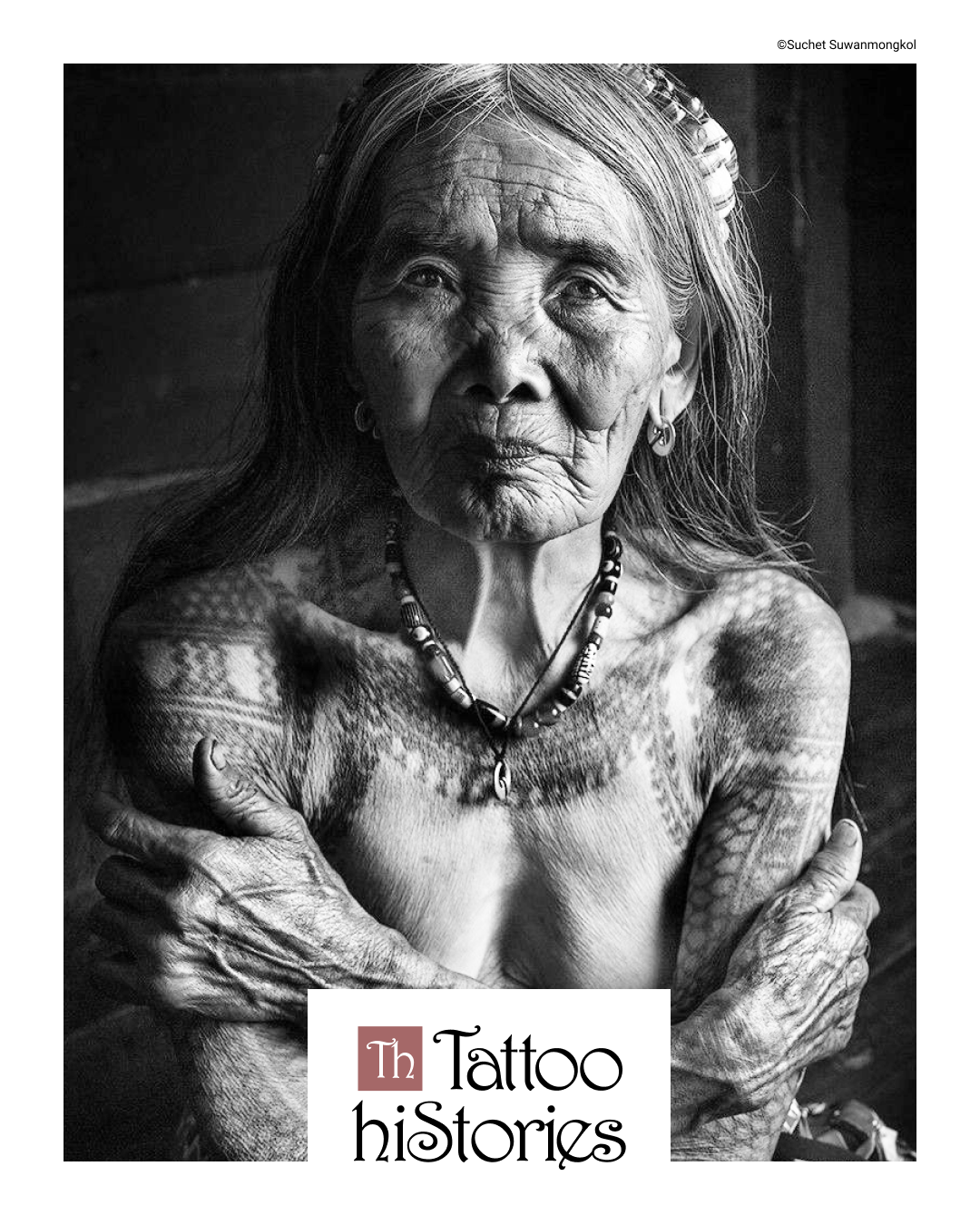Eikon Tattoo herStories: The Legends - Whang-Od

At 102 years old, Whang-Od Oggay (also known as Whang-od or Maria Oggay) is the Philippines' oldest mambabatok (traditional Kalinga tattooist), and until recently, the last. She's been performing the ancient art of hand-tapped tattoos since she was 15.
“I didn’t plan to do this when I grew up,” Whang-Od explains. “When I was little, girls only had the option of becoming housewives. But my uncle and father were the tribe’s tattoo artists, and when they became too old, they asked me to take over so that we could still afford to buy rice.”

Her tools are simple: a foot-long bamboo stick, a thorn from a pomelo tree, soot scraped off the bottom of a pot, a dried coconut shell mixing bowl and water.

Whang-Od’s tattoos feature ancient Baybayin and tribal patterns. Most of them symbolize bravery and nature; stars, ferns, steps, rice bundles, centipedes and python scales, and most cover the arms, back and chest.
Ancient Art of Kalinga Tattoos
Traditionally, the hand-tapped tattoos were earned by indigenous Butbut warriors. The tattoo marked someone who had killed an enemy or settled a score in a feud. The warriors' tattoo was a symbol that both recognized valour and inspired fear. When interviewed by CNN in 2017, Whang-Od explained:
"Once they've killed someone, they are eligible for a tattoo," explains Whang Od. "Everyone knew when one of the warriors has killed someone because he would announce it to everyone."
For the women, the tattoo was seen to enhance their beauty. A woman's tattoos also indicated the family’s wealth, as they would pay for her tattoos. The more tattoos a woman had, the more attractive she was to the men in the village.
In the same interview, Whang-Od recalled of her teenage years:
"Back then they would say: 'Go get a tattoo so you would look beautiful.' "
From Obscurity to Tattoo Tourism Destination
Whang-Od became internationally known when American anthropologist Lars Krutak featured her in his 2009 documentary series, “Tattoo Hunter”. Since then, thousands of visitors annually, make the 15-hour drive north of Manila to the mountain village of Buscalan to be tattooed by her. The village can only be accessed by a one-mile hike from the nearest dirt road through a forest and rice terraces.

Manila-based photographer Jake Verzosa travelled to the Cordillera mountains, between 2009 and 2013, and photographed Kalinga women whose bodies are tattooed with Batok. His book The Last Tattooed Women of Kalinga, is a collection of Verzosa’s photographs, documenting the work of Whang-Od, the last mambabatok.
Whang-Od's Legacy Will Live On...
The art of Batok can only be passed down to blood relatives. Whang-Od never married or had children. So for the last several years, she's been training her grandnieces Elyang Wigan and Grace Palicas to ensure this ancient practice carries on long after she is gone. In the meantime, she shows no signs of slowing down, as she told CNN writer Kate Springer in a 2017 interview:
"As long as I can see well, I will keep giving tattoos. I'll stop once my vision gets blurry." - Whang-Od

“When I pass on, I will bring my tattoos with me in the afterlife. Everything else is left behind.” - Whang-Od
Learn More about Whang-Od
To learn more about the life and art of the oldest mambabatok Whang-Od, you can check out these documentaries:
CBC Gem features Wang-od in the first episode of their new docu-series "Skindigenous".
Matador Network's short documentary "Whang-Od: The World's Last True Tattoo Artist"
Brent Fosters Legacy Project "While I'm Still Here: The Last Mambabatok"
Other articles referenced: "Pambabatok: A Tattooing Technique of the ButBut Tribe in the Philippines" by Royce Lyssah Malabonga




